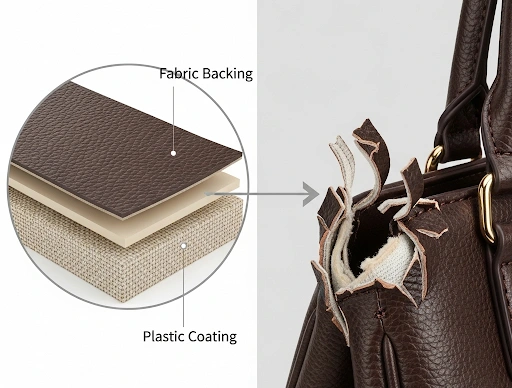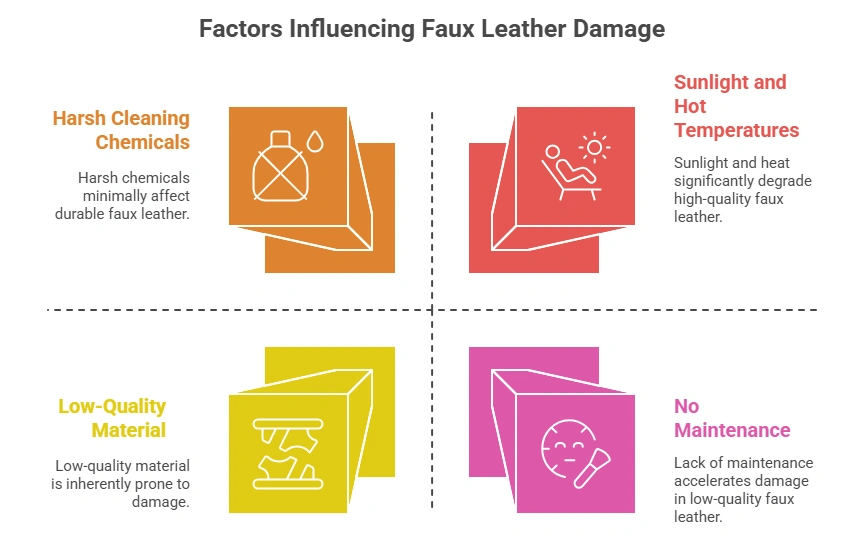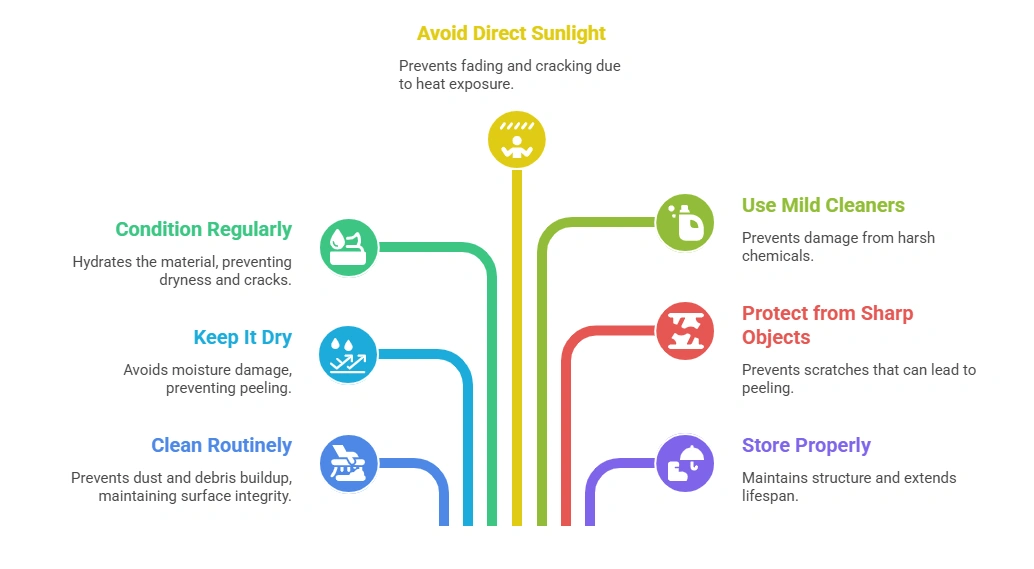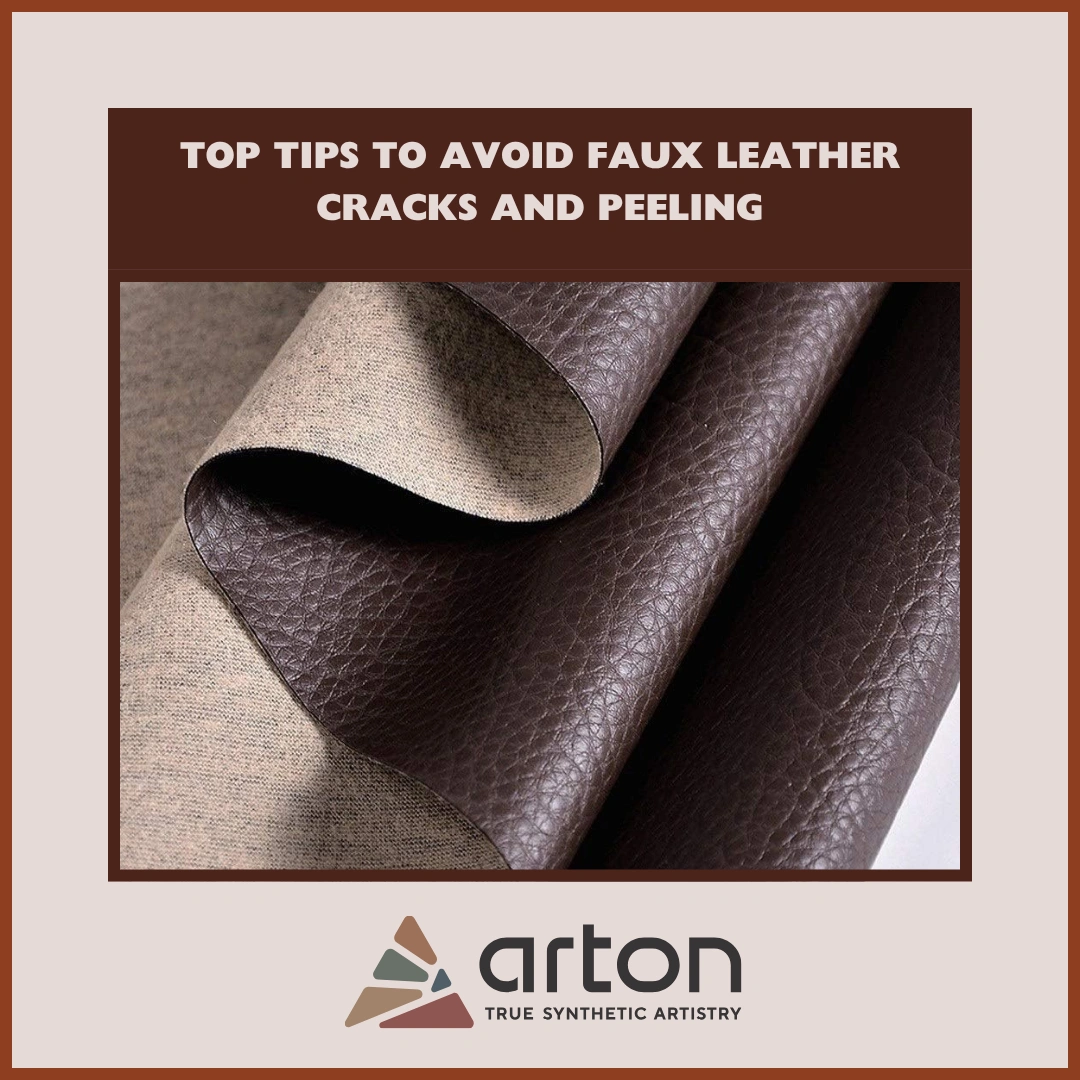01 September, 2025
Faux leather is a fashionable yet affordable alternative to genuine leather and found commonly in furniture, car seats, clothing, and accessories.However, despite its versatility and visual appeal, faux leather cracks and peeling can quickly ruin its appearance and reduce product life. Keeping your synthetic leather products shiny new with proper attention and prevention-few things can be easier.
What is Faux Leather and Why Does It Peel and Crack?

Faux leather Also known as leatherette or synthetic leather is a man-made substance imitating the appearance and texture of genuine leather. It is usually a plastic base, like polyurethane (PU) or polyvinyl chloride (PVC), and covered with matte texture to resemble animal hide. Artificial leather is affordable, waterproof, and considered cruelty-free, which is why it can be a default solution when shopping furniture, clothing, bags, and car interiors.
Cracking and peeling often occur when the synthetic surface dries out, is scratched, or undergoes sudden temperature or humidity changes. Using incorrect cleaning products, skipping regular upkeep, or allowing moisture to settle can break down the outer layer, leading to those unsightly faux leather cracks.
What Causes Faux Leather Cracks and Peeling?

Before jumping into solutions, it's important to understand why faux leather cracks in the first place.
- Sunlight and Hot Temperatures: When the material is in direct sunlight or very hot weather, it can dry out and become hard to the point that it cracks.
- Harsh Cleaning Chemicals: Detergent, alcohol-based cleaners or rough cleaning gadgets may damage the safeguard on faux leather.
- No Maintenance: Unlike real leather, the artificial leather one does require some maintenance. Micro-abrasions, which arise due to the build-up of dust and grime, result in peeling.
- Low-Quality Material: Cheap faux leather can be non-elastic, not as strong and easier to get damaged over time and expose leatherette to more damage.
Top Tips to Prevent Cracks and Peeling

1. Clean Routinely (But Gently)
Faux leather can be worn out by dust and debris. Use a Soft, dry microfiber cloth or brush-attached vacuum to clean the faux leather surfaces once every few weeks. With a cloth with a mild soap and lukewarm water mixture you can work with light stains, never soak the material.
2. Keep It Dry
Faux leather does not like moisture. Always ensure your item is completely dry after cleaning. Too much water may also weaken the layers of adhesive or the underside of the fabric, causing faux leather peeling.
3. Condition to Prevent Dryness
Similar to genuine leather, fake leather can be hydrated. Apply a specialized conditioner that is recommended to care for synthetic leather to keep it flexible and shiny avoiding dryness and cracks. This will also contribute to prevention of cracked leatherette surfaces and prolonging of leather life.
4. Avoid Direct Sunlight and Heat
Faux leather furniture should not be placed in front of windows, radiators, or places of heating to hasten the drying process and hasten cracking or fading of faux leather. Put items in non-direct sunlight and heat where possible.
5. Choose the Right Cleaning Products
The synthetic surface can be easily destroyed by harsh chemicals, bleach, abrasive pads or alcohol based cleaners. Use mild soap solutions or other products that are suggestive of your furniture manufacturer as a prevention measure to good peeling.
6. Protect Against Sharp Objects and Pets
Maintain pets with claws and never put keys or scissors or any edged object directly on faux leather. After scratching, the faux leather more readily becomes exposed to moisture and faux leather peeling.
7. Store and Handle Properly
When your fake leather product is not being used, it should be kept in a cool dry place without being subjected to direct light and it should also not be folded or creased. This will help maintain its structure and extend leather life.
Best Cleaning and Maintenance Practices
Here’s a step-by-step cleaning routine to avoid faux leather damage:
- Step 1: Dust off with a dry microfiber cloth.
- Step 2: Prepare a cleaning solution with water and a few drops of mild soap.
- Step 3: Wipe gently in circular motions.
- Step 4: Dry immediately with a clean, soft towel.
- Step 5: Apply a faux leather-safe conditioner or moisturizer for synthetic leather care.
Avoid using: Bleach, ammonia, alcohol, nail polish remover, or any rough-bristled brushes.
How to Store Faux Leather Items Correctly
Storage plays a major role in maintaining faux leather condition. Here are a few rules to follow:
- Store items in a cool, dry place with good air circulation.
- Avoid plastic covers—opt for breathable cotton or linen fabric bags.
- Don’t stack heavy items on faux leather products as it can lead to creases and surface strain.
- Keep away from heaters or damp corners.
Quick Fixes and Repair Solutions for Minor Damage
If your faux leather has already started to show early signs of damage, don’t panic. Some faux leather repair options include:
- Faux Leather Repair Kits: These come with filler paste, color matchers, and sealing tools.
- DIY Patching: For larger peels, adhesive-backed faux leather patches can be cut and applied to blend with the surface.
- Sealing Peels: Clear adhesive or vinyl repair glue can stop the peeling from spreading.
If the damage is beyond repair, consult a professional upholstery or faux leather repair service.
Conclusion
Faux leather delivers outstanding value, but it requires consistent, careful maintenance. Cleaning gently, conditioning the surface, controlling sunlight and moisture, and guarding against scratches go a long way toward preventing faux leather cracks and peeling. By following these simple yet effective care routines, you can keep your faux leather sofas, chairs, and accessories looking clean, stylish, and like new for years to come.
People Also Ask
1. How do I keep faux leather from cracking?
Routine cleaning with gentle products, conditioning with synthetic-safe treatments, and protecting from sunlight and moisture are the best methods.
2. Can you fix peeling faux leather?
Minor faux leather peeling might be managed with DIY faux leather repair kits, but widespread damage often requires replacement of the cover or upholstery.
3. How long does synthetic leather last?
With proper synthetic leather care, high-quality faux leather can last 5 to 10 years. Regular cleaning and avoiding environmental stress extend leather life significantly.
4. What are the best products for caring for faux leather?
Use mild soap, water, microfiber cloths, and dedicated faux leather conditioners. Always avoid harsh chemicals and abrasives that cause leatherette damage.
5. What is the best conditioner for faux leather?
Water-based conditioners or those specifically designed for synthetic leather care are best. Avoid oil-heavy ones meant for genuine leather.



